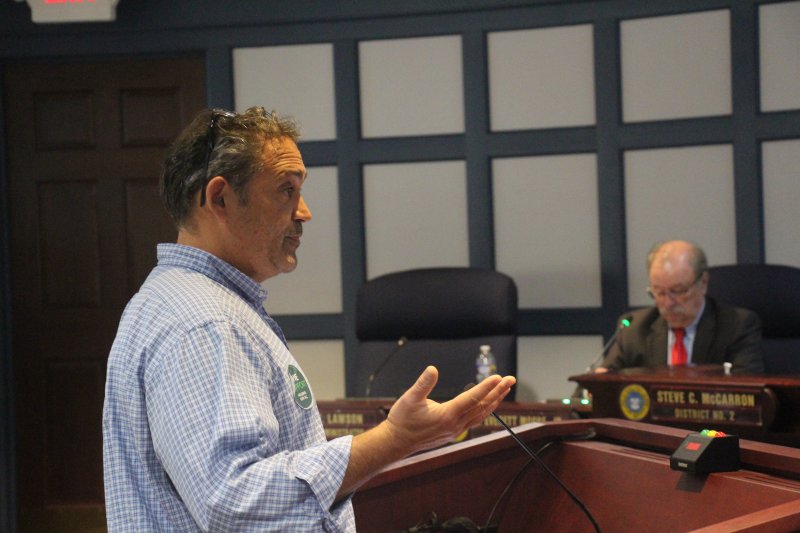Sussex County Council delays Cool Spring Crossing decision
After a nearly six-hour Nov. 4 public hearing that included lengthy presentations by the applicant and a citizens group, Sussex County Council delayed a decision on a proposed 1,922-unit home and commercial project.
The Cool Spring Crossing project includes single-family houses and multi-family residential buildings as well as 450,975 square feet of commercial space on Route 9 west of Lewes.
Council chambers were filled to capacity with more than 130 people as developer attorney Jim Fuqua and consultants outlined the $836 million project and answered questions from council members over nearly three hours.
After a few people spoke in support of the plan, five Sussex Preservation Coalition representatives followed, offering a detailed presentation raising traffic concerns and saying the plan is incompatible with surrounding land uses.
Council in the end unanimously agreed to seek additional information from the Delaware Department of Transportation, Lewes and Milton fire departments, the state forester and Office of State Planning Coordination.
Council will have two weeks to formulate questions for submission. Those groups will be given two weeks to reply. The responses will be posted on the county website, and the applicant and public will have two weeks to submit their own comments on the responses.
The commercial space has options such as a grocery store, convenience store, retail shopping, bank, 100-room hotel, theater, YMCA, assisted-living facility with medical offices, educational facility and restaurants.
Council is considering four requests that received recommendation for approval July 2 from the county planning & zoning commission:
- A zoning change for the 637-acre site from AR-1, agricultural-residential, to MR-RPC, medium-density residential planned community
- An amendment to the future land-use map, changing the property from low density to coastal area
- A conditional use for an educational facility for 1,800 students with a 500-seat auditorium as part of the Towne Center in the development. It would comprise 45,000-square-foot and 30,000-square-foot buildings. One would be for programs offering associate degrees and professional certifications, while the other has adult learning classes
- A conditional use for a 71,500-square-foot assisted-living and independent care building for 100 residents and a 25,000-square-foot medical office building. Both would be near the Bayhealth Emergency and Urgent Care Center.
Fuqua described in detail how he believes the project – which would be built out over 20 years – complies with county laws and development goals of the state and county.
Developer Carl M. Freeman Companies has built several large projects in Sussex County over 50 years, Fuqua said.
Plans include 750 affordable housing units, but Councilwoman Jane Gruenebaum and project opponents noted only 125 are guaranteed to remain affordable long term and rents would be too high for many to afford.
“We think the purpose of a master planned community describes the way Cool Spring Crossing was designed,” Fuqua said. “The applicant has pursued this application because Freeman believes that Cool Spring Crossing ... is vastly superior compared to the permitted cluster subdivision of over 1,250 standalone houses.”
While the site is considered rural on county and state planning maps, Fuqua said there are residential neighborhoods and businesses nearby, and it is adjacent to a coastal area designated for growth. Some opponents took issue with that characterization, pointing out nearby farms.
Tim Kriebel, the mayor of Ventnor City, N.J., who owns land less than a quarter of a mile from the site where he plans to build a home, was among a few people who backed the plan.
“This is an opportunity to make it a more livable community that I think would probably be a blueprint for communities to come,” Kriebel said.
Jon Horner, a Home Builders Association of Delaware board member, noted developers are discouraged by significant opposition to their projects, and they often choose to build single-family homes over better alternatives.
Horner, a lawyer for Schell Brothers and Ocean Atlantic Companies, served on the county’s land-use reform working group, which recently offered 20 recommendations to improve county laws to limit housing growth.
“Make no mistake, this is the superior plan, by far,” Horner said of Cool Springs Crossing. “The alternative is 1,270 single-family homes. It includes no housing that is available to work force. You are virtually ensuring that you are building 1,270 homes for people who primarily did not grow up in Sussex County.”
“Not now, but not never” was a theme introduced by Sussex Preservation Coalition member Joe Pika as he began the opposition’s case.
Council should delay its decision until it creates the next comprehensive plan at the end of 2028, he said. Also, Route 9 should be widened before the development is built, Pika said. Road work is not expected for years.
The developer has agreed to pay for 22 road and intersection improvements in the area.
Fuqua said it would be unfair to ask the developer to wait two years.
The cumulative effect of Cool Spring Crossing and other projects in the area on traffic was alarming for residents and council.
Council members had many questions about traffic studies and projections for the developer’s representatives and three DelDOT employees who attended the meeting.
The development would generate an estimate of more than 30,000 daily vehicle trips, counting each vehicle twice, once entering the site and once leaving, according to studies. Route 9 now has about 13,000 daily trips.
However, many factors and assumptions went into the projections, and more information will be sought by council. Council members worried about the cumulative effect of other nearby developments, some not yet built.
“We did deem that this development is quite hard, one of the hardest that we had analyzed,” said Pamela Steinebach, DelDOT director of operations and maintenance, who added a detailed study was done by the agency.
“I would feel better if I had some assurance that it was in the [state] capital plan to dualize Route 9,” said Councilman John Rieley. “I have a hard time reconciling the numbers from a common-sense point of view. I’m not a traffic expert.”
The project would remove 103 of the 217 acres of trees, which concerned Gruenebaum.
Councilman Steve McCarron said early in the meeting that he and his daughter signed a petition against the project during his political campaign last year, but he pledged to be fair and impartial in considering the applications.
Kevin Conlon came to the Cape Gazette with nearly 40 years of newspaper experience since graduating from St. Bonaventure University in New York with a bachelor's degree in mass communication. He reports on Sussex County government and other assignments as needed.
His career spans working as a reporter and editor at daily newspapers in upstate New York, including The Daily Gazette in Schenectady. He comes to the Cape Gazette from the Cortland Standard, where he was an editor for more than 25 years, and in recent years also contributed as a columnist and opinion page writer. He and his staff won regional and state writing awards.
Conlon was relocating to Lewes when he came across an advertisement for a reporter job at the Cape Gazette, and the decision to pursue it paid off. His new position gives him an opportunity to stay in a career that he loves, covering local news for an independently owned newspaper.
Conlon is the father of seven children and grandfather to two young boys. In his spare time, he trains for and competes in triathlons and other races. Now settling into the Cape Region, he is searching out hilly trails and roads with wide shoulders. He is a fan of St. Bonaventure sports, especially rugby and basketball, as well as following the Mets, Steelers and Celtics.


























































